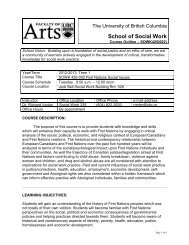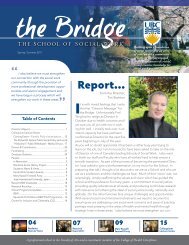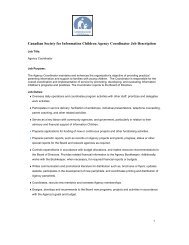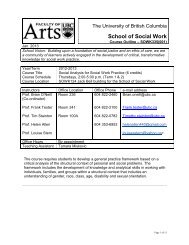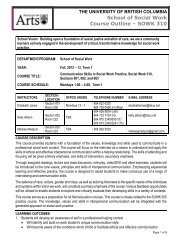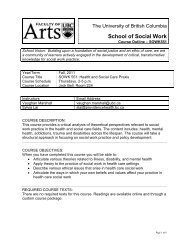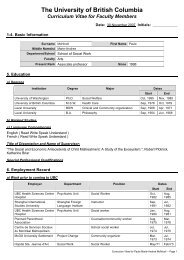Equity Case Studies Report - School of Social Work - University of ...
Equity Case Studies Report - School of Social Work - University of ...
Equity Case Studies Report - School of Social Work - University of ...
You also want an ePaper? Increase the reach of your titles
YUMPU automatically turns print PDFs into web optimized ePapers that Google loves.
UBC school <strong>of</strong> social work equity and diversity strategic plan: A compilation <strong>of</strong> case studies 65<br />
designated groups. As another example, UC Berkeley has affirmative action guidelines<br />
that apply to all <strong>of</strong> the <strong>University</strong> <strong>of</strong> California schools (see Appendix E for more<br />
information). Affirmative action policies and guidelines are essential in improving<br />
educational equity, diversity, and inclusion in faculty recruitment, hiring, support, and retention.<br />
It is also important to establish a set <strong>of</strong> complementary and interrelated policies regarding antiracism,<br />
anti-discrimination, and accessibility. It is recommended that the <strong>School</strong> <strong>of</strong> <strong>Social</strong> <strong>Work</strong><br />
at UBC begin a process <strong>of</strong> establishing such policies and guidelines.<br />
It is also vital to note that discussions regarding affirmative action – both for faculty<br />
hiring and student admissions – frequently include the concepts <strong>of</strong> merit versus special treatment<br />
and “leveraging diversity” (Iverson, 2007). This is problematic as it does not acknowledge that<br />
merit<br />
Affirmative action policies and guidelines are essential in improving educational equity,<br />
diversity, and inclusion in faculty recruitment, hiring, support, and retention. It is also<br />
important to establish a set <strong>of</strong> complementary and interrelated policies regarding antiracism,<br />
anti-discrimination, and accessibility.<br />
is<br />
based on Euro-western, patriarchal normative standards (Iverson, 2007), and that it is a criteria<br />
created by those in power (Blackmore, 2002). As Iverson (2007) illustrates, racially minoritized<br />
faculty are frequently seen as outsiders, disadvantaged, and at risk; rather than being recognized<br />
for the contributions they bring to the university. It is recommended that during UBC <strong>School</strong> <strong>of</strong><br />
<strong>Social</strong> <strong>Work</strong>’s process <strong>of</strong> establishing equitable hiring and admission policies and practices, the<br />
<strong>School</strong> acknowledges the inherent inequity that exists in these perspectives.<br />
Another example <strong>of</strong> processes and practices that address recruiting, hiring, supporting,<br />
and retaining minoritized faculty is provided by the <strong>University</strong> <strong>of</strong> Sydney (U <strong>of</strong> S), which has a<br />
Staff and Student Equal Opportunity Unit on-campus. This program promotes the hiring <strong>of</strong><br />
women, people with English as a second language, Indigenous people, and people with



